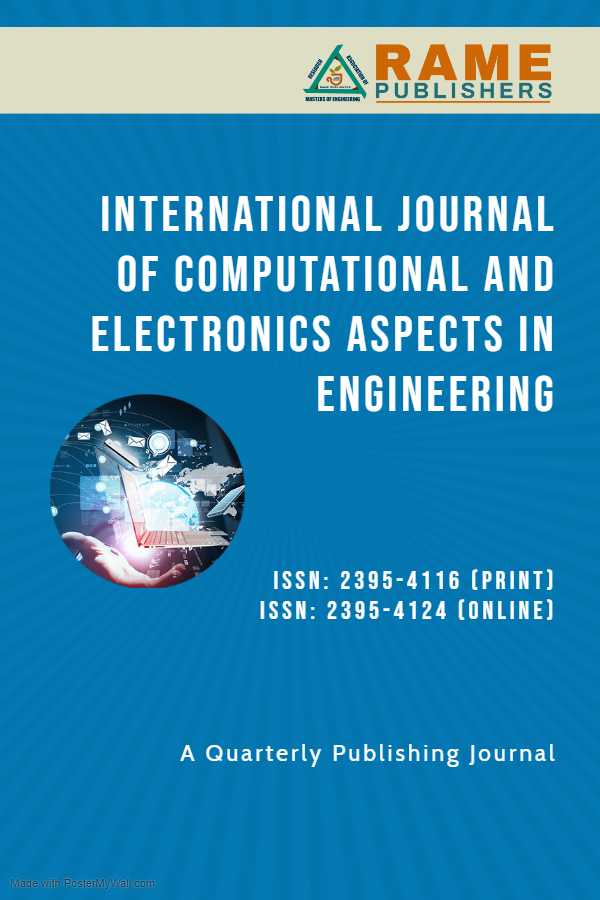Utilizing Convolutional Neural Networks for the Identification of Lung Cancer
Serri Ismael Hamad
International Journal of Computational and Electronic Aspects in Engineering
Volume 6: Issue 1, March 2025, pp 35-41
Author's Information
Serri Ismael Hamad1
Corresponding Author
1University of Thi-Qar, College of Education for Pure Sciences, Iraq
serriismael@utq.edu.iq
Abstract:-
Lung cancer is a disease that spreads worldwide and claims many lives each year. Applying appropriate treatments that increase the chances of patient survival requires early detection. Lung cancer identification has greatly benefited from the use of computer-aided diagnosis methods, especially when convolutional neural networks are used to analyze CT images. A methodology for creating a convolutional neural network that addresses the selection of hyperparameters is presented in this paper. A convolutional neural network is developed as a proof of concept using a small dataset using this methodology. The results support the application of the proposed methodology, resulting in a high-accuracy network that accurately classifies 97.5% of the test data that was not visible.Index Terms:-
FPGA, PN, XSG, Chaos, Gold CodeREFERENCES
- W. H. Organization. "World health statistics 2018: monitoring health for the SDGs, sustainable development goals."
https://www.who.int/publications/i/item/9789241565585
- W. Alakwaa, M. Nassef, and A. Badr, "Lung cancer detection and classification with 3D convolutional neural network
(3D-CNN)," International Journal of Advanced Computer Science and Applications, vol. 8, no. 8, 2017.
- N. S. Reddy and V. Khanaa, "Intelligent deep learning algorithm for lung cancer detection and classification,"
Bulletin of Electrical Engineering and Informatics, vol. 12, no. 3, pp. 1747-1754, 2023.
- C. Zhang et al., "Toward an expert level of lung cancer detection and classification using a deep convolutional
neural network," The oncologist, vol. 24, no. 9, pp. 1159-1165, 2019.
- W.-J. Choi and T.-S. Choi, "Automated pulmonary nodule detection system in computed tomography images: A
hierarchical block classification approach," Entropy, vol. 15, no. 2, pp. 507-523, 2013.
- G. Perez and P. Arbelaez, "Automated lung cancer diagnosis using three-dimensional convolutional neural networks,"
Medical & biological engineering & computing, vol. 58, pp. 1803-1815, 2020.
- S. G. Armato III et al., "The lung image database consortium (LIDC) and image database resource initiative (IDRI): a
completed reference database of lung nodules on CT scans," Medical physics, vol. 38, no. 2, pp. 915-931, 2011.
- F. Ciompi et al., "Automatic classification of pulmonary peri-fissural nodules in computed tomography using an
ensemble of 2D views and a convolutional neural network out-of-the-box," Medical image analysis, vol. 26, no. 1, pp.
195-202, 2015.
- S. Hawkins et al., "Predicting malignant nodules from screening CT scans," Journal of Thoracic Oncology, vol. 11,
no. 12, pp. 2120-2128, 2016.
- V. T. Ponnada and S. N. Srinivasu, "Efficient CNN for lung cancer detection," Int J Recent Technol Eng, vol. 8, no.
2, pp. 3499-505, 2019.
- C.-J. Lin, S.-Y. Jeng, and M.-K. Chen, "Using 2D CNN with Taguchi parametric optimization for lung cancer
recognition from CT images," Applied Sciences, vol. 10, no. 7, p. 2591, 2020.
- B. Almas, K. Sathesh, and S. Rajasekaran, "A deep analysis of Google Net and AlexNet for lung cancer detection,"
Int. J. Eng. Adv. Technol.(IJEAT), vol. 9, pp. 395-399, 2019.
- S. Wang, L. Dong, X. Wang, and X. Wang, "Classification of pathological types of lung cancer from CT images by deep
residual neural networks with transfer learning strategy," Open Medicine, vol. 15, no. 1, pp. 190-197, 2020.
- Z. Xiao, B. Liu, L. Geng, F. Zhang, and Y. Liu, "Segmentation of lung nodules using improved 3D-UNet neural
network," Symmetry, vol. 12, no. 11, p. 1787, 2020.
- Z. Zhang, G. Wen, and S. Chen, "Weld image deep learning-based on-line defects detection using convolutional neural
networks for Al alloy in robotic arc welding," Journal of Manufacturing Processes, vol. 45, pp. 208-216, 2019.
- D. Bacioiu, G. Melton, M. Papaelias, and R. Shaw, "Automated defect classification of SS304 TIG welding process
using visible spectrum camera and machine learning," NDT & E International, vol. 107, p. 102139, 2019.
- A. Baldominos, Y. Saez, and P. Isasi, "Evolutionary design of convolutional neural networks for human activity
recognition in sensor-rich environments," Sensors, vol. 18, no. 4, p. 1288, 2018.
- S. Albelwi and A. Mahmood, "A framework for designing the architectures of deep convolutional neural networks,"
Entropy, vol. 19, no. 6, p. 242, 2017.
- R. Andonie and A.-C. Florea, "Weighted random search for CNN hyperparameter optimization," arXiv preprint
arXiv:2003.13300, 2020.
- R. Rojas, Neural networks: a systematic introduction. Springer Science & Business Media, 2013.
- A. A. Hadi, "The Impact of Artificial Neural Network (ANN) on the Solar Energy Cells: A Review," International
Journal of Computational & Electronic Aspects in Engineering (IJCEAE), vol. 5, no. 1, 2024.
- S. Sathasivam, "Comparing Logic Programming in Radial Basis Function Neural Network (RBFNN) and Hopfield Neural
Network," 2020.
- S. Sathasivam and W. A. T. Wan Abdullah, "Logic mining in neural network: Reverse analysis method," Computing, vol.
91, pp. 119-133, 2011.
To view full paper, Download here
To View Full Paper
For authors
Author's guidelines Publication Ethics Publication Policies Artical Processing Charges Call for paper Frequently Asked Questions(FAQS) View All Volumes and IssuesPublishing with




